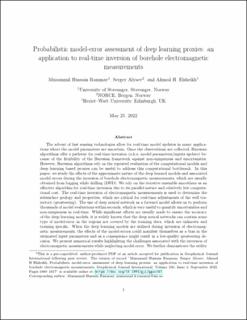| dc.description.abstract | The advent of fast sensing technologies allow for real-time model updates in many applications where the model parameters are uncertain. Once the observations are collected, Bayesian algorithms offer a pathway for real-time inversion (a.k.a. model parameters/inputs update) because of the flexibility of the Bayesian framework against non-uniqueness and uncertainties. However, Bayesian algorithms rely on the repeated evaluation of the computational models and deep learning (DL) based proxies can be useful to address this computational bottleneck. In this paper, we study the effects of the approximate nature of the deep learned models and associated model errors during the inversion of borehole electromagnetic (EM) measurements, which are usually obtained from logging while drilling. We rely on the iterative ensemble smoothers as an effective algorithm for real-time inversion due to its parallel nature and relatively low computational cost. The real-time inversion of EM measurements is used to determine the subsurface geology and properties, which are critical for real-time adjustments of the well trajectory (geosteering). The use of deep neural network (DNN) as a forward model allows us to perform thousands of model evaluations within seconds, which is very useful to quantify uncertainties and non-uniqueness in real-time. While significant efforts are usually made to ensure the accuracy of the DL models, it is widely known that the DNNs can contain some type of model-error in the regions not covered by the training data, which are unknown and training specific. When the DL models are utilized during inversion of EM measurements, the effects of the model-errors could manifest themselves as a bias in the estimated input parameters and as a consequence might result in a low-quality geosteering decision. We present numerical results highlighting the challenges associated with the inversion of EM measurements while neglecting model-error. We further demonstrate the utility of a recently proposed flexible iterative ensemble smoother in reducing the effect of model-bias by capturing the unknown model-errors, thus improving the quality of the estimated subsurface properties for geosteering operation. Moreover, we describe a procedure for identifying inversion multimodality and propose possible solutions to alleviate it in real-time. | en_US |
